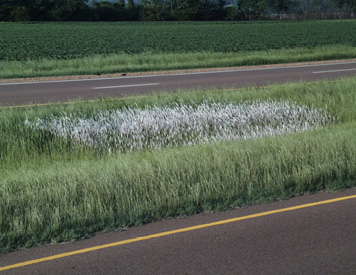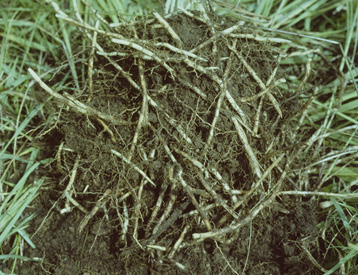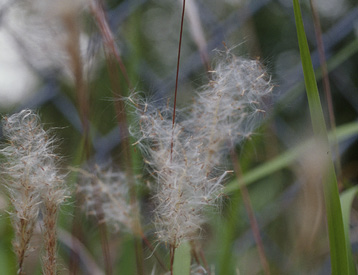Cogongrass



Cogongrass’s scientific name is Imperata cylindrica (L.) Beauv. (Incl. I. brasiliensis Trin.), but it is commonly known as Japanese bloodgrass, Red Baron bloodgrass, or speargrass. Cogongrass is designated as the seventh-worst weed in the world. It is native to tropical and subtropical areas of the eastern hemisphere. This grassy weed spreads vegetatively and by wind-dispersed seeds. Cogongrass produces underground horizontal stems, or rhizomes, which root at each node and produce a new stem. These rhizomes remain dormant during winter and produce new plants the next spring.
Cogongrass was both accidentally and purposely introduced in the southern United States in the early 1910s and 1920s. Farmers planted cogongrass for pastures and erosion control, but cogongrass has poor nutritional value for livestock feed and is too weedy for erosion control. Unfortunately, cogongrass with reddish to maroon foliage is still sold by some nurseries as an ornamental grass called Japanese bloodgrass or Red Baron bloodgrass.
Cogongrass is regulated as a federal noxious weed. It is also a state noxious weed in Mississippi, so it cannot be moved within the state boundaries without a permit from the Bureau of Plant Industry under the Mississippi Department of Agriculture and Commerce.
Description
Vegetative Growth
Cogongrass produces upright, smooth stems 6–47 inches tall that form loose or densely compacted stands (Figure 1). Its dense stems and rooting system choke out other vegetation (Figure 2). Leaves of cogongrass display a midrib that is offset (closer to one leaf margin than the other).
Flowering
An unusual characteristic of cogongrass is its flowering pattern. It flowers immediately after the transition from dormancy to full greenup in the spring, typically from March to May, although warm winters may cause earlier greenup and flowering. Cogongrass can also flower following frost, fire, mowing, tillage, or other disturbances. Most native grasses that resemble cogongrass flower well after plants have turned green, rather than immediately after greenup. Flowers typically occur at the top of the stem and are easily identified by silvery or whitish, silky hairs attached to the seed that create the appearance of a feathery plume (Figure 3). Silver beardgrass [Bothriochloa saccharoides (Sw.) Rydb; Syn. Andropogon sacchariodes Sw.] can be confused with cogongrass. However, silver beardgrass is smaller, forms clumps rather than dense stands, and flowers in summer.
Each cogongrass plant can produce up to 3,000 seeds per season. Cross-pollination is necessary for seed production. Seedlings are frequently found in open sites that have been disturbed by clear-cutting, burning, tillage, excavation, grading, fire ant mounds, or other disturbances. Seedlings begin to produce rhizomes about 4 weeks after emergence.
Dispersal
Cogongrass is typically spread by wind, vehicles, equipment, animals, and contaminated soil.
Habitat
In the midsouth and other southern states, cogongrass usually grows in noncultivated sites, including pastures, orchards, fallow fields, forests, parks, and natural areas as well as in highway, electrical utility, pipeline, and railroad rights-of-way. Cogongrass prefers sandy soils with low nutrient levels, although it will inhabit more fertile sites.
Distribution
Cogongrass occurs as a weed in Alabama, Florida, Georgia, Louisiana, Mississippi, Oregon, South Carolina, Texas, and Virginia. Several thousand acres are infested with cogongrass in the southeastern United States; more than 1.2 billion acres are infested worldwide. Unfortunately, this weed continues to spread.
Control Methods
Chemical
Currently, there is no single treatment that effectively eliminates cogongrass infestations. Roundup Ultra, Roundup Pro, or other brands of glyphosate (41 percent active ingredient formulations) at 5 quarts per acre or as a 1.5 percent solution will suppress cogongrass. Repeated applications each year for several years are needed for control. Applications of Arsenal, imazapyr, Polaris, or Habitat (2 pounds imazapyr per gallon formulation) at 48 ounces per acre can be used in certain areas and provide excellent control up to 1 year after application. Because Arsenal and Roundup are nonselective, applications may damage nearby desirable vegetation. Since Arsenal remains in the soil for long periods, its effectiveness on cogongrass and other plants may continue up to a year after application. Do not apply imazapyr herbicides within 2 times the dripline of any desirable vegetation.
Mechanical
Cogongrass will not persist in areas frequently tilled, so frequent tillage can control cogongrass in certain sites.
Physical
Mowing or burning will remove aboveground cogongrass vegetation, but these methods open the plant canopy for emergence of seedlings and new stems from rhizomes.
Cultural
Broadcasting or drilling Roundup Ready soybeans into cogongrass, followed by glyphosate applications, has been a very effective control method.
References
Brown, D. (1944). Anatomy and reproduction in Imperata cylindrica. Imperial Agriculture Bureaux, Great Britain, Joint Publication No. 7:15–18. 66 p.
Bryson, C. T. (1984). Weed alert: Cogongrass [Imperata cylindrica (L.) Beauv.]. Southern Weed Society Newsletter, 17:8.
Bryson, C. T., & Carter, R. (1993). Cogongrass, Imperata cylindrica, in the United States. Weed Technology, 7:1005–1009.
Coile, N. C., & Shilling, D. G. (1993). Cogongrass, Imperata cylindrica (L.) Beauv: A good grass gone bad! Florida Department of Agriculture and Consumer Services, Division of Plant Industry, Botany Circular, No. 28.
Dickens, R. (1974). Cogongrass in Alabama after sixty years. Weed Science, 22:177–179.
Holm, L. G., & Pucknett, D. L., Pancho, J. B., & Herberger, J. P. (1977). The World’s Worst Weeds: Distribution and Biology. University Press of Hawaii.
Hubbard, C. E. (1944). Imperata cylindrica. Taxonomy, distribution, economic significance and control. Imperial Agriculture Bureau. Joint Publication No. 7, Imperial Bureau Pastures and Forage Crops, Aberystwyth, Wales, Great Britain.
McDonald, S. K., Shilling, D. G., Okoli, C. A. N., Bewick, T., Grodon, A., Hall, D., & Smith. R. (1996). Population dynamics of cogongrass. Proceedings of the Southern Weed Science Society, 49:156.
Patterson, D. T., Terrell, E. E., & Dickens, R. (1979). Cogongrass in Mississippi. Mississippi Agriculture and Forestry Experiment Station Research Report, 46(6):1–3.
Shilling, D. G., Johnson, E. R. R. L., Gaffney, J. F., Brecke, B., Colvin, D., Hall, D., Tanner, G., Querns, R., & Dozier, H. (1998). The influence of timing of herbicide application on cogongrass management and the influence of introduced species on cogongrass management. Final Report, Hernando County Public Works.
USDA, NRCS. (2007). The PLANTS Database (http://plants.usda.gov, 9/5/2007).
Publication 3190 (POD-04-24)
By John D. Byrd Jr., PhD, Extension/Research Professor, Plant and Soil Sciences; Victor Maddox, PhD, Senior Research Associate, Plant and Soil Sciences; and Charles T. Bryson, PhD, Research Botanist, USDA Crop Production Systems Research Unit.
The Mississippi State University Extension Service is working to ensure all web content is accessible to all users. If you need assistance accessing any of our content, please email the webteam or call 662-325-2262.



